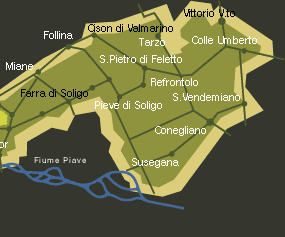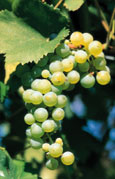|  About
50 kms north of Venice in Italy is a small historical
town of Conegliano, known for a long time for its well
known painter Cima. (pronounced as Chee-ma). It has
an old castle, beautiful old palaces, abbeys and churches
with several buildings still adorning centuries old
fresco paintings outside the houses. Even where the
dilapidated buildings have been repainted, wherever
the old frescos could be visible, the frescos have been
preserved, even though in patches. One can walk through
the town with craned necks and appreciate the pride
with which the locals have maintained the history and
culture of this place, barely. About
50 kms north of Venice in Italy is a small historical
town of Conegliano, known for a long time for its well
known painter Cima. (pronounced as Chee-ma). It has
an old castle, beautiful old palaces, abbeys and churches
with several buildings still adorning centuries old
fresco paintings outside the houses. Even where the
dilapidated buildings have been repainted, wherever
the old frescos could be visible, the frescos have been
preserved, even though in patches. One can walk through
the town with craned necks and appreciate the pride
with which the locals have maintained the history and
culture of this place, barely.
Conegliano is also the starting point, an important
base and a connection to the rest of the beautiful mountainous
terrain full of bejewelled vineyards. The hills are
rolling here and as one progresses towards Valdobbiadene,
27 kms away, through the winding roads going up and
down the mountains at 50-500 meters level, the view
of the lush vines is breathtaking.
The hills are known as Prosecco Hills and
this stretch of road is known as the Prosecco
Road of Conegliano and Valdobbiadene, which
also passes by the town of Vittorio Veneto, where royalty
and nobility used to live.
What is Prosecco: Generally labelled
as Prosecco, it is a sparkling wine made from the indigenous
Prosecco grapes being grown in this region for at lest
300 years and thus qualifying to be called autoctonous.
DOC Prosecco Appellation has been
granted this region to ensure the quality of grapes,
process and wine. Although this is the main varietal
used, the rules allow for up to 15% blend of other local
minor varieties- Verdiso, Perera, Bianchetta and Prosecco
Lungo:
 a. Verdiso-was
discovered in 18th century. It increases acidity and
gives more tangy flavour. As such it becomes more important
in hot years when the acidity tends to be low. a. Verdiso-was
discovered in 18th century. It increases acidity and
gives more tangy flavour. As such it becomes more important
in hot years when the acidity tends to be low.
b. Perera-enhances the fragrance and
fruity flavour of the DOC Prosecco wines.
c. Bianchetta- on the other hand is
a discovery of 16th century that makes more wine more
mellow and is thus useful for colder vintages.
d. Prosecco Lungo- has been discovered
recently. It gives a better structure.
DOC Rules: Grape varietals and the
percentage used, region, process of vinification, rules
regarding bottling and marketing tests for quality before
despatch are five rules that govern the production of
wines by 153 producers who are members of the Consorzio
Tutela del Vino Prosecco DOC di Conegliano e Valdobbiadene
, formed in 1962.
Like many other consortiums in Italy, the role played
by this body of producers is dual- help marketing and
also control quality, two seemingly difficult roles
to handle , vested under one authority but working well,
nevertheless since 1969, when the DOC was granted.
Vines: For the technically oriented
Doppio Capovolto (double upside down) and Guyot form
of canopy management are used.
Process of producing Prosecco: Grapes
are hand harvested between mid-September to end-October;
the Consorzio decides the harvest dates. The grapes
are gentle pressed. 100 Kg grapes give 70 liters wine.
First the base wine is produced by vinification for
15- 20 days at 18-20° C in stainless steel tanks-producing
wine at about 11% alcohol level. Secondary fermentation
is carried out in stainless steel tanks known as auto
claves. Yeast is added to this wine and second-time
fermenting it at 15-18 ° C to about 12% alcohol
and a pressure of 5+ atmosphere for Spumante and 2.5+
for frizzante before the wine is bottled in the individual
bottles. At the end, temperature is reduced close to
0° C to stabilise the sugar level. Unlike Champagne,
no tirage is added at the time of bottling and the ullage
(gap between the wine level and the cork) is not an
important issue. Some reserve wine may be added in small
amounts though.
Although DOC Prosecco is the main product of the region,
a few producers also produce Champagne style wine with
double fermentation within the bottle. Several wineries
like Villa Sandi have long underground caves where the
bottles rest for years before they are finally disgorged.
Production: The popularity of these
wines can be gauged from the statistics: from 6.2 million
bottles in 1995 the production has gone up to 13 millions
in 2006 with an export of 30%.
Style: Extra Dry is the most
common style where 12-20 gms of residual sugar is allowed.
This may be slightly sweet but in most tastings I found
it an acceptable level for the Indian palate, especially,
if one has to have it with Indian cuisine or with meals.
 Dry
is the sweet style with 20gms +sugar. There is also
a special appellation, DOC Cortizze, in the S. Stefano
area in the commune of Valdobbiadene, one of the 15
that form the Prosecco DOC zone. By law, all Cortizzes
must be Dry. Though they are expensive , rated high
and considered precious, I found them too sweet for
our palate. They are better suited for desserts like
a pineapple gateau or even gulab jamuns. Our palate
is not yet ready to accept dessert wines though one
can have them with the spicy Indian food . Dry
is the sweet style with 20gms +sugar. There is also
a special appellation, DOC Cortizze, in the S. Stefano
area in the commune of Valdobbiadene, one of the 15
that form the Prosecco DOC zone. By law, all Cortizzes
must be Dry. Though they are expensive , rated high
and considered precious, I found them too sweet for
our palate. They are better suited for desserts like
a pineapple gateau or even gulab jamuns. Our palate
is not yet ready to accept dessert wines though one
can have them with the spicy Indian food .
The driest wine is Brut with a sugar level
of up to 15 gms.-with most producers sticking to 5-9
grams in this category. This is the latest international
style that works as a simple but fruity no brainer aperitif
and will offer a good market for the product in India,
if priced reasonably to compete with Spanish Cavas.
There are areas outside this DOC that make Prosecco
wines; even in this region non DOC or IGT wines are
available at cheaper prices. But the finesse, and fruit
does not come close to the good quality and yet affordable
DOC variety.
So pick up a glass of a Brut or Extra Dry fresh, fruity,
crisp but simple DOC Prosecco anywhere, any time, especially
as an aperitif and during summer evenings, and say like
Germans who drink a lot of this moniker-'Prost'
....and enjoy!
Subhash Arora
|